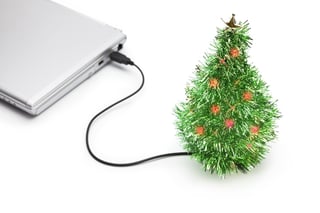Your Office Christmas Lights Could Be Messing with Your WiFi, and Other Enterprise Internet Surprises

In addition to supporting thousands of connections a day, enterprise networks have to overcome the dozens of interference issues that come with a large office environment — and that includes your festive holiday lights.
By sheer size alone, enterprise wireless networks present IT teams with a host of challenges. Creating and maintaining a high-functioning wireless infrastructure capable of supporting hundreds or even thousands of users in a BYOD environment requires strong underlying network design principles and comprehensive, transparent network management practices.
However, even if enterprise network administrators get everything right at a rudimentary level, there are a wide variety of factors at play in large office environments that can unexpectedly hamper your building’s WiFi connectivity, often coming from the devices you’d least expect.
That’s because the most common cause of service slowdowns and poor network performance is radio-frequency interference (RFI), or the disruption of WiFi signals traveling through the air either by other devices using the same frequency or by overly dense structures or materials. What follows are four of the most disruptive sources of interference that often fly under the radar of enterprise IT professionals.
Non-Networked Electrical Appliances
Devices that don’t themselves connect to the internet may seem innocuous, but in reality, they present a host of potential interference issues. Wireless networks typically use either a 2.4GHz or 5GHz frequency to transmit their signals, frequencies that other devices like cordless phones, Bluetooth-enabled technologies, security systems, and kitchen appliances also rely on. Indeed, research from the Farpoint Group shows that wireless data throughput can fall by nearly 63% when the transmission passes within 25 feet of an in-use microwave.
Larger electronics like televisions, fax machines, and elevators generate short-range interference even when they’re not in use because of the electrical signals that are constantly emanating from their power supplies. In short, enterprises should be sure to take the location of break rooms and tech-heavy conference rooms into account when designing their WiFi infrastructure.
Dense Building Materials and Poor Office Layouts
An office building’s physical infrastructure also plays a significant role in determining the best way to create a top-notch wireless infrastructure. Many materials naturally block a wide range of radio frequencies, preventing wireless signals from reaching their destination, especially metal, concrete, brick, marble, and tile.
Large furniture like filing cabinets and bookshelves and hefty metal appliances like refrigerators also obstruct wireless signals, especially if access points are placed too close to them. Neighboring offices’ WiFi networks can also produce interference, so avoid placing critical networking infrastructure near shared walls or windows.
Fish Tanks (and Water Generally)
Water is another substance that’s very effective at absorbing the kind of radio waves broadcasted by enterprise-grade access points, which is why we advise against placing wireless infrastructure near large volumes of water — from fish tanks, to boilers, to water coolers. Fish tanks in particular hamper connectivity because in addition to their water content, they usually consume a great deal of electricity.
Shockingly, even the water content in our bodies can produce a very small amount of interference, meaning connectivity issues can begin to emerge if a group of employees all stand around an access point at once. There’s nothing an enterprise can do about its employees’ body chemistry, of course, but it’s wise to take into account the impact of numerous bodies on a critical ap in a frequently bustling space like a break room.
Christmas Lights
Metal in and of itself causes high levels of signal interference, but this effect is amplified when the metal is electrified, as in the case of wiring. As such, intricate arrays of wires like Christmas lights tend to create a surprising amount of interference. Telecom providers claim that Christmas lights alone can reduce broadband speeds by as much as 25%, partially because they are kept on for extended periods of time (unlike, for instance, a microwave).
Knowing Where You Stand
In an enterprise setting, pinpointing each and every source of potential RFI can be a deeply involved and painstaking endeavor. In order to achieve reliable WiFi coverage and performance throughout an entire office or enterprise campus, it’s critically important to gain a deep understanding of the RF environment in which the network is deployed.
Luckily, Turn-key Technologies has over two decades of experience helping enterprises design, implement, and monitor their wireless networks. Our wireless site survey gives key enterprise stakeholders a holistic view of how their network is structured, what’s hampering its performance, and how they can begin to optimize it.




